Evaluation of Thermal Fatigue Life and Crack Morphology in Brake Discs of Low-Alloy Steel for High-Speed Trains
Abstract
1. Introduction
2. Experimental Methods
3. Results
3.1. Thermal Fatigue Crack Propagation and Micromorphology
3.2. Microhardness and Microstructure
3.3. Crack Tip Morphology
3.4. Fracture Behavior
3.5. Wear Property
4. Discussion
5. Conclusions
- (1)
- Introducing additional elements in cast steel adequately hinders crack growth rate and yields favorable precipitates to overcome fatigue cracking. Chromium and vanadium contents can develop a dense film structure on the crack propagation surface to prevent further deterioration of the fracture surface;
- (2)
- Materials with better anti-dissolution and anti-aggregation ability in the precipitates have more resistance against cracking and fatigue failure. The destruction of precipitated phases consumes crack propagation energy and subsequently passivates the crack tip;
- (3)
- The hardness of steel material for brake discs changes in the same way. It shows that it quickly softens in the early stage of the cycle and stabilizes after the cycle;
- (4)
- The microstructure significantly dictates fatigue properties and crack formation ultimately affects material performance. Fine, homogenous, uniform, and regular microstructures provide resistance to alleviate crack growth rate;
- (5)
- The precipitate size, uniform distribution, anti-dissolution, and anti-aggregation growth ability contribute to fatigue resistance.
Author Contributions
Funding
Institutional Review Board Statement
Informed Consent Statement
Data Availability Statement
Acknowledgments
Conflicts of Interest
References
- Modanloo, A.; Talaee, M.R. Analytical thermal analysis of advanced disk brake in high speed vehicles. Mech. Adv. Mater. Struct. 2018, 27, 209–217. [Google Scholar] [CrossRef]
- Belhocine, A.; Abdullah, O.I. A thermomechanical model for the analysis of disc brake using the finite element method in frictional contact. J. Therm. Stress. 2019, 43, 305–320. [Google Scholar] [CrossRef]
- Hong, H.; Kim, M.; Lee, H.; Jeong, N.; Moon, H.; Lee, E.; Kim, H.; Suh, M.; Chung, J.; Lee, J. The thermo-mechanical behavior of brake discs for high-speed railway vehicles. J. Mech. Sci. Technol. 2019, 33, 1711–1721. [Google Scholar] [CrossRef]
- Wang, Z.; Zhang, J. Thermomechanical Coupling Simulation and Analysis of Wet Multi-Disc Brakes During Emergency Braking. J. Physics: Conf. Ser. 2021, 1875, 012005. [Google Scholar] [CrossRef]
- Goo, B.-C.; Lim, C.-H. Thermal fatigue of cast iron brake disk materials. J. Mech. Sci. Technol. 2012, 26, 1719–1724. [Google Scholar] [CrossRef]
- Samrout, H. Fatigue behaviour of 28CrMoV5-08 steel under thermomechanical loading. Int. J. Fatigue 1998, 20, 555–563. [Google Scholar] [CrossRef]
- Yang, Z.; Han, J.; Li, W.; Li, Z.; Pan, L.; Shi, X. Analyzing the mechanisms of fatigue crack initiation and propagation in CRH EMU brake discs. Eng. Fail. Anal. 2013, 34, 121–128. [Google Scholar] [CrossRef]
- Dufrénoy, P.; Bodovillé, G.; Degallaix, G. Damage mechanisms and thermomechanical loading of brake discs. Eur. Struct. Int. Soc. 2002, 167–176. [Google Scholar] [CrossRef]
- Sakamoto, H.; Hirakawa, K. Fracture Analysis and Material Improvement of Brake Discs. JSME Int. J. Ser. A 2005, 48, 458–464. [Google Scholar] [CrossRef]
- Le Gigan, G.; Vernersson, T.; Lundén, R.; Skoglund, P. Disc brakes for heavy vehicles: An Experimental study of temperatures and cracks. Proc. Inst. Mech. Eng. Part D J. Automob. Eng. 2014, 229, 684–707. [Google Scholar] [CrossRef]
- Dong, Y.; Garbatov, Y.; Soares, C.G. A two-phase approach to estimate fatigue crack initiation and propagation lives of notched structural components. Int. J. Fatigue 2018, 116, 523–534. [Google Scholar] [CrossRef]
- Jirandehi, A.P.; Chakherlou, T. A fatigue crack initiation and growth life estimation method in single-bolted connections. J. Strain Anal. Eng. Des. 2019, 54, 79–94. [Google Scholar] [CrossRef]
- Hobbacher, A.F. Erratum to: Recommendations for Fatigue Design of Welded Joints and Components. Int. Pub. 2019, E3. [Google Scholar] [CrossRef]
- Chepil, R.; Stankevych, O.; Ostash, O.; Klym, B. The methodology of evaluation and monitoring of the fatigue fracture at macrocrack initiation stage. Procedia Struct. Integr. 2019, 16, 211–217. [Google Scholar] [CrossRef]
- Luo, P.; Yao, W.; Susmel, L.; Li, P. Prediction of fatigue damage region with the use of the notch critical plane approach for crack initiation and propagation. Int. J. Fatigue 2020, 135. [Google Scholar] [CrossRef]
- Baumgartner, J. Enhancement of the fatigue strength assessment of welded components by consideration of mean and residual stresses in the crack initiation and propagation phases. Weld. World 2016, 60, 547–558. [Google Scholar] [CrossRef]
- Remes, H. Strain-based approach to fatigue crack initiation and propagation in welded steel joints with arbitrary notch shape. Int. J. Fatigue 2013, 52, 114–123. [Google Scholar] [CrossRef]
- Murakami, Y.; Miller, K. What is fatigue damage? A view point from the observation of low cycle fatigue process. Int. J. Fatigue 2005, 27, 991–1005. [Google Scholar] [CrossRef]
- Dong, P.; Society, A.W. Quantitative Weld Quality Acceptance Criteria: An Enabler for Structural Lightweighting and Additive Manufacturing. Weld. J. 2020, 99, 39s–51s. [Google Scholar] [CrossRef]
- Zerbst, U.; Madia, M.; Vormwald, M.; Beier, H. Fatigue strength and fracture mechanics – A general perspective. Eng. Fract. Mech. 2018, 198, 2–23. [Google Scholar] [CrossRef]
- Benedetti, M.; Santus, C. Mean stress and plasticity effect prediction on notch fatigue and crack growth threshold, combining the theory of critical distances and multiaxial fatigue criteria. Fatigue Fract. Eng. Mater. Struct. 2019, 42, 1228–1246. [Google Scholar] [CrossRef]
- Erdman, N.; Bell, D.C.; Reichelt, R. Scanning Electron Microscopy. III-Vs Review 2019, 229–318. [Google Scholar] [CrossRef]
- Hodoroaba, V.-D. Energy-dispersive X-ray spectroscopy (EDS). Analytical Electron Microscopy Mater. Sci. 2019, 397–417. [Google Scholar] [CrossRef]
- Weißgraeber, P.; Leguillon, D.; Becker, W. A review of Finite Fracture Mechanics: Crack initiation at singular and non-singular stress raisers. Ingenieur-Archiv 2015, 86, 375–401. [Google Scholar] [CrossRef]
- Chattopadhyay, A.; Glinka, G.; El-Zein, M.; Qian, J.; Formas, R. Stress Analysis and Fatigue of welded structures. Weld. World 2011, 55, 2–21. [Google Scholar] [CrossRef]
- Liu, D.; Pons, D.J. Crack Propagation Mechanisms for Creep Fatigue: A Consolidated Explanation of Fundamental Behaviours from Initiation to Failure. Metals 2018, 8, 623. [Google Scholar] [CrossRef]
- Monshi, A.; Foroughi, M.R.; Monshi, M.R. Modified Scherrer Equation to Estimate More Accurately Nano-Crystallite Size Using XRD. World J. Nano Sci. Eng. 2012, 02, 154–160. [Google Scholar] [CrossRef]
- Lu, Y.; Yang, J.; Xu, J.; Guo, Z.; Gu, J. Microstructure and mechanical properties of a low-carbon HDQ&P steel. Heat Treat. Surf. Eng. 2019, 1, 87–96. [Google Scholar] [CrossRef]
- Wu, D.; Wang, F.-M.; Cheng, J.; Li, C.-R. Effect of Nb and V on the continuous cooling transformation of undercooled austenite in Cr–Mo–V steel for brake discs. Int. J. Miner. Met. Mater. 2018, 25, 892–901. [Google Scholar] [CrossRef]
- Li, C.; Xie, L.; Zhao, H.; Song, J.; Zhao, Z. A Transition Size of Dividing Crack Initiation and Propagation Phases and the Fatigue Total Life Prediction Approach. J. Fail. Anal. Prev. 2019, 19, 1380–1388. [Google Scholar] [CrossRef]
- Wang, J.; Zafar, M.Q.; Chen, Y.; Pan, P.; Zuo, L.; Zhao, H.; Zhang, X. Tribological Properties of Brake Disc Material for a High-Speed Train and the Evolution of Debris. Lubricants 2022, 10, 168. [Google Scholar] [CrossRef]
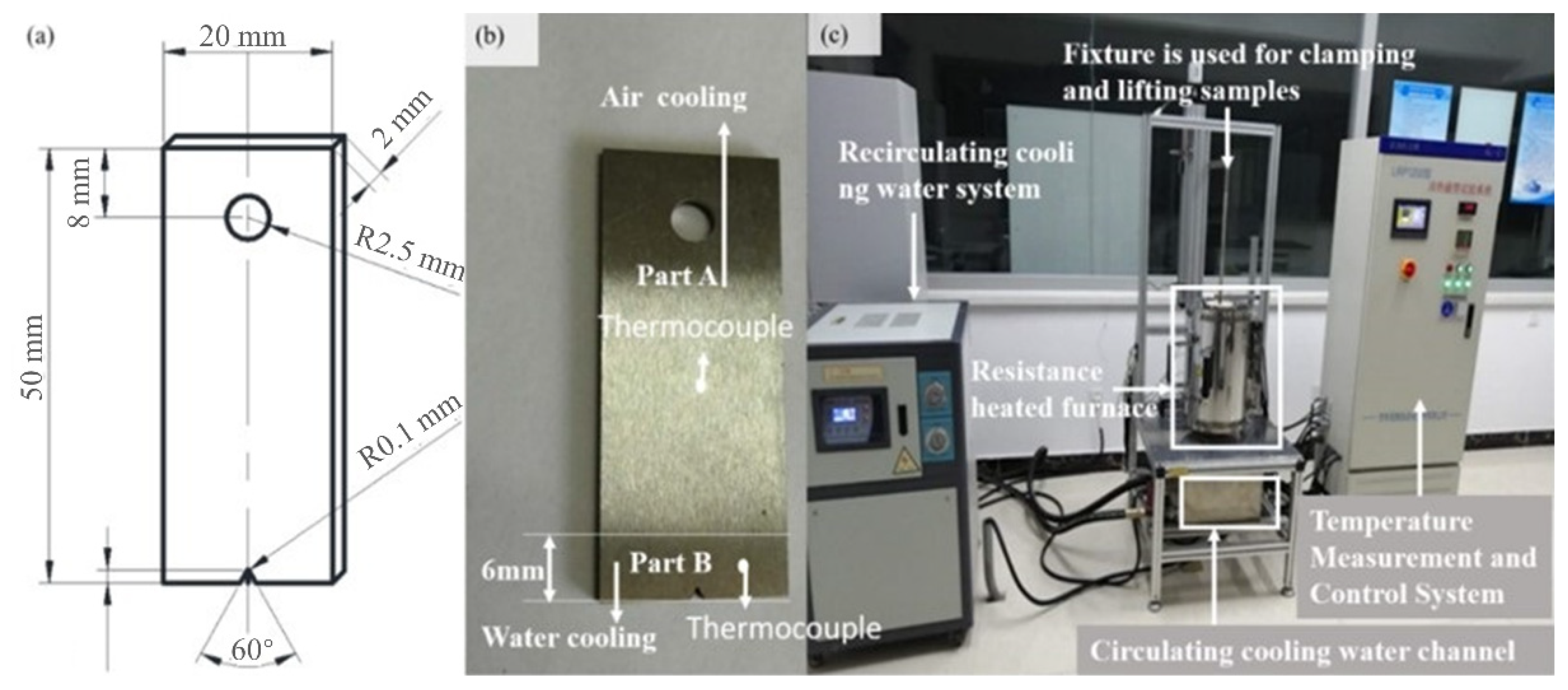
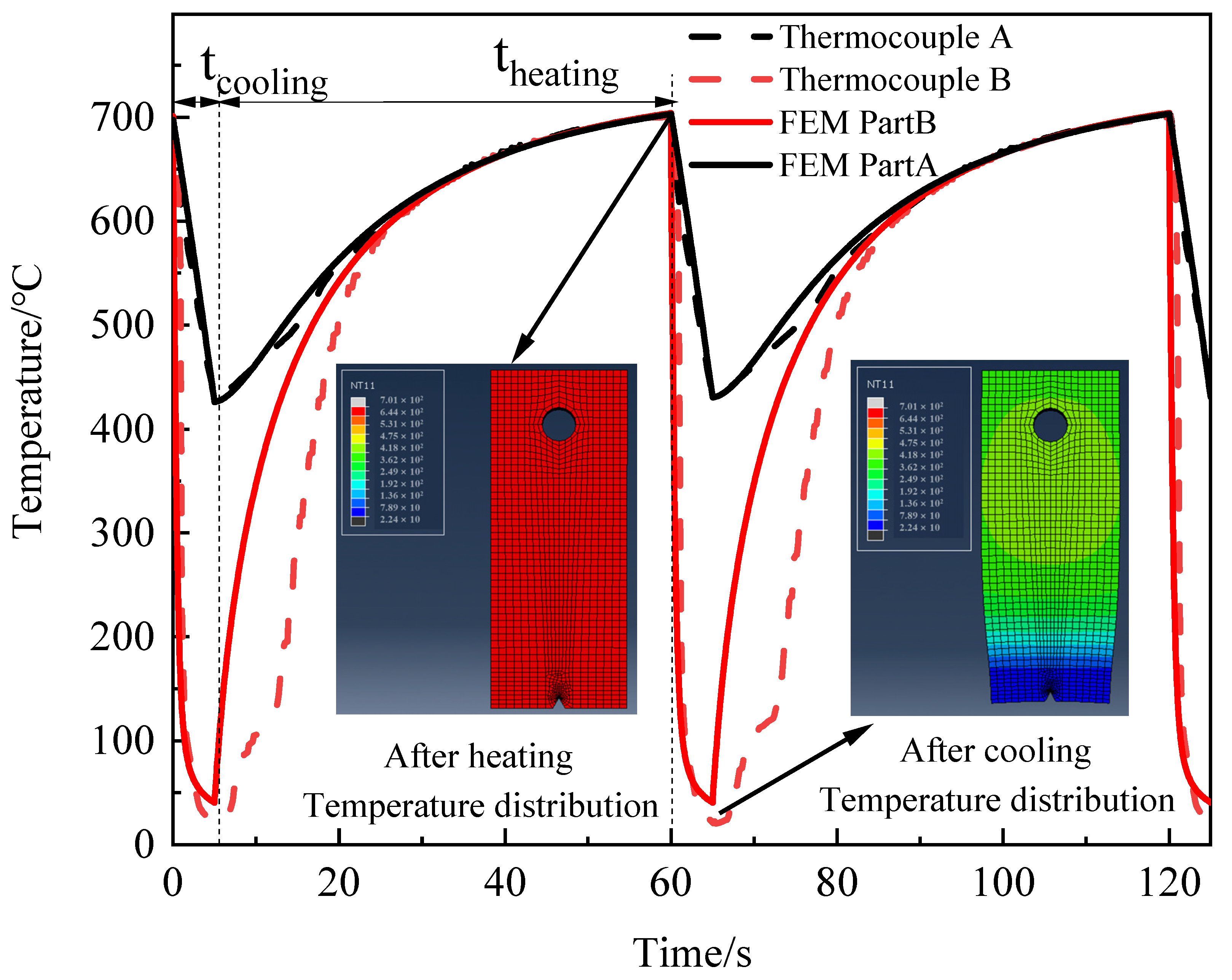
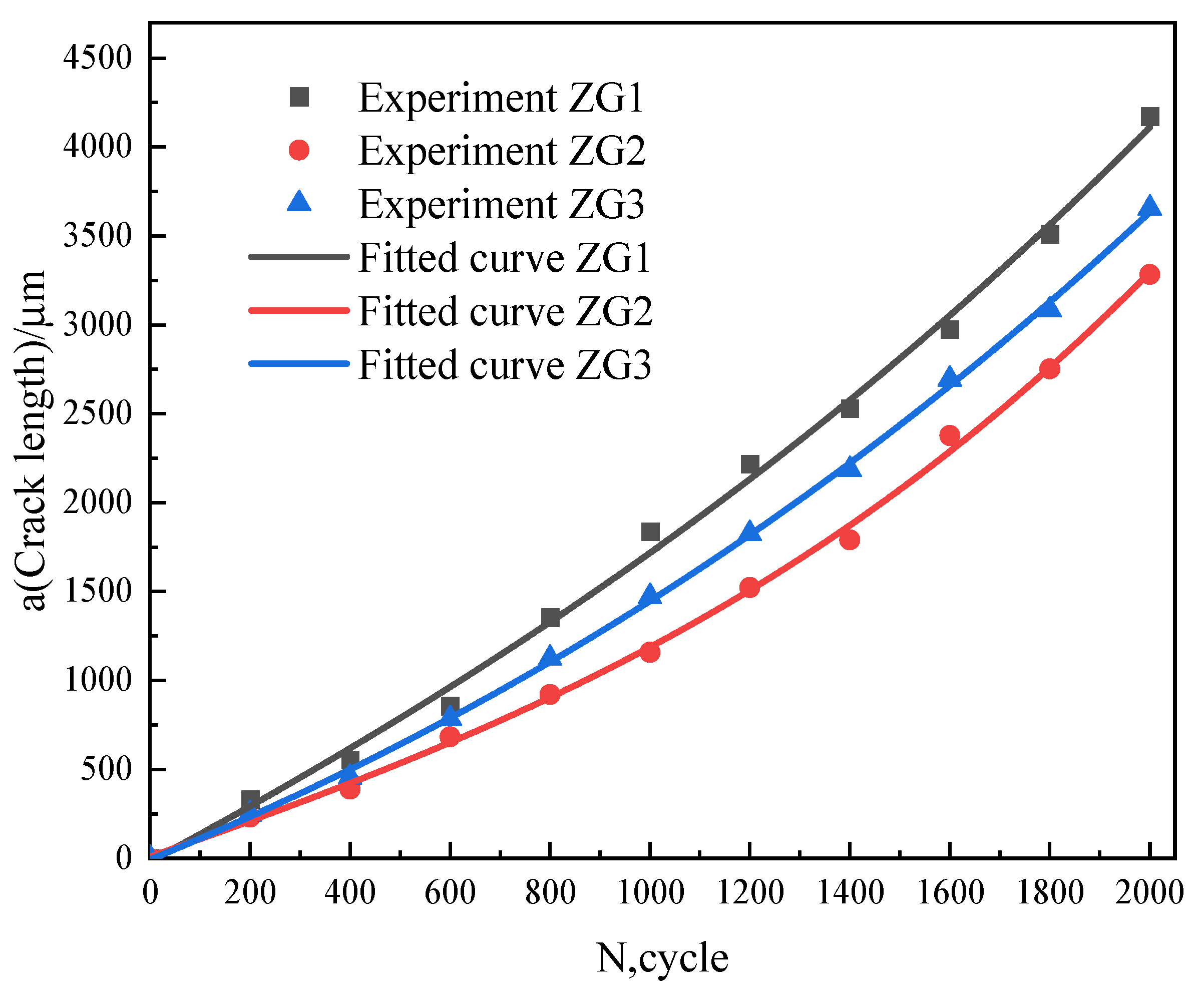
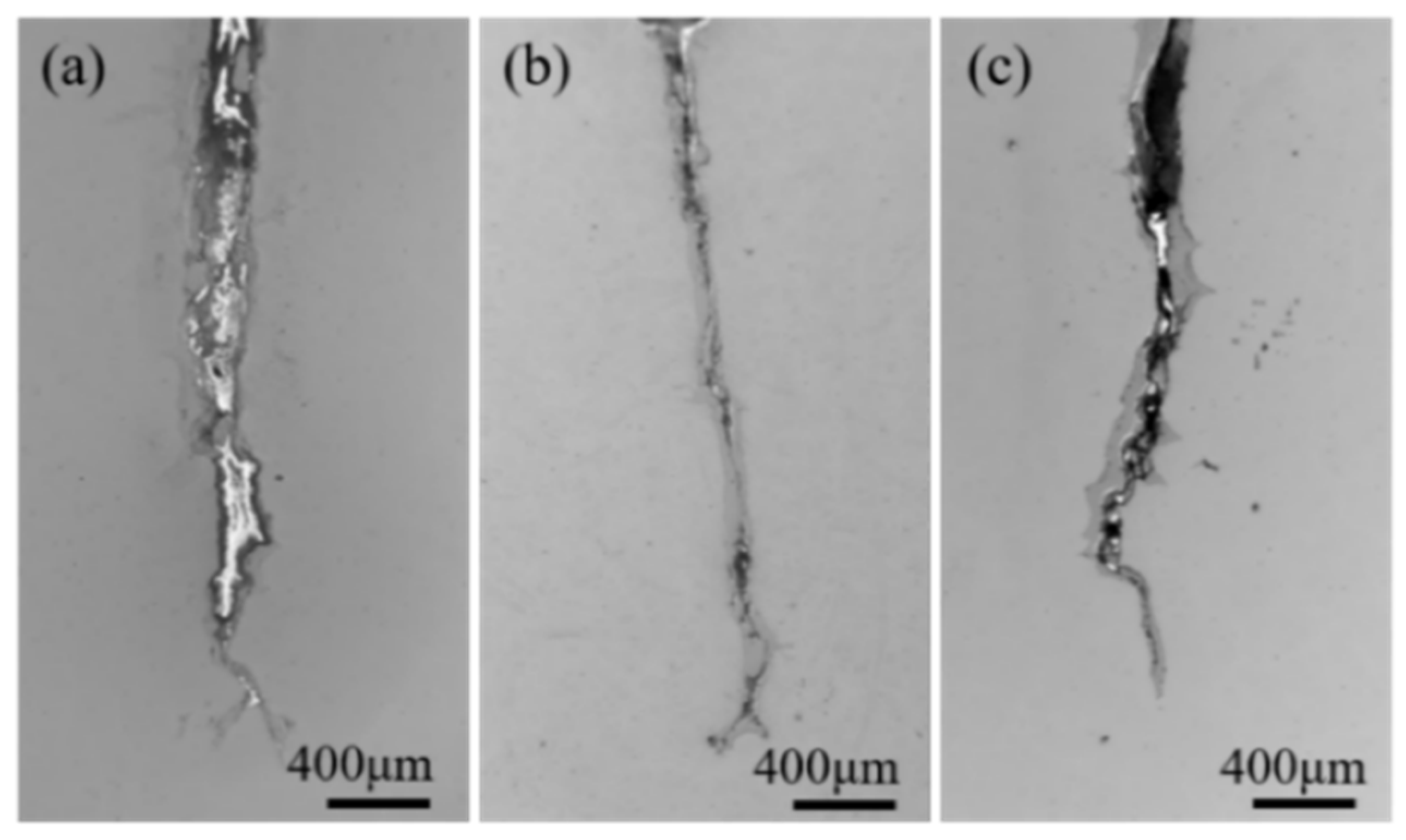
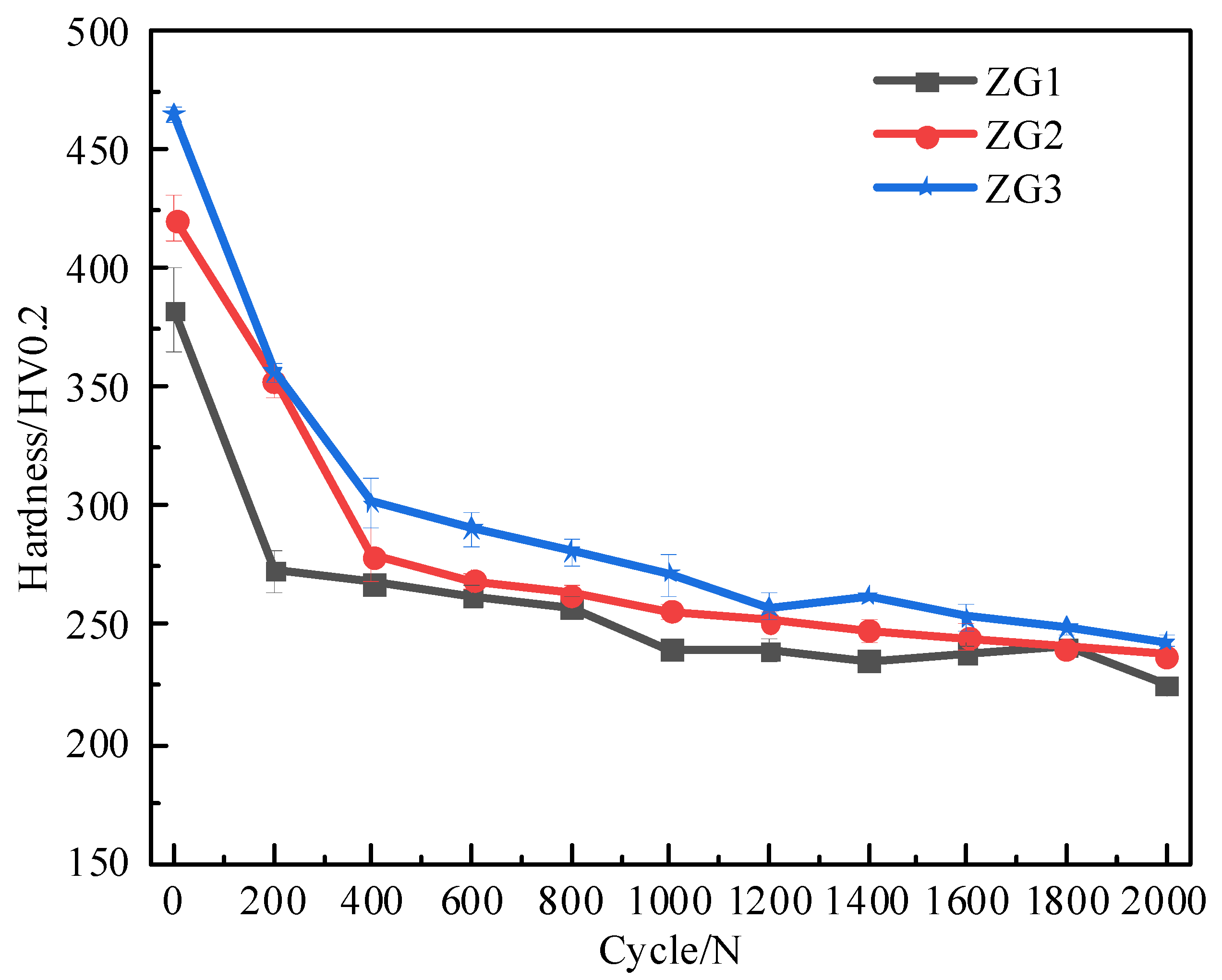
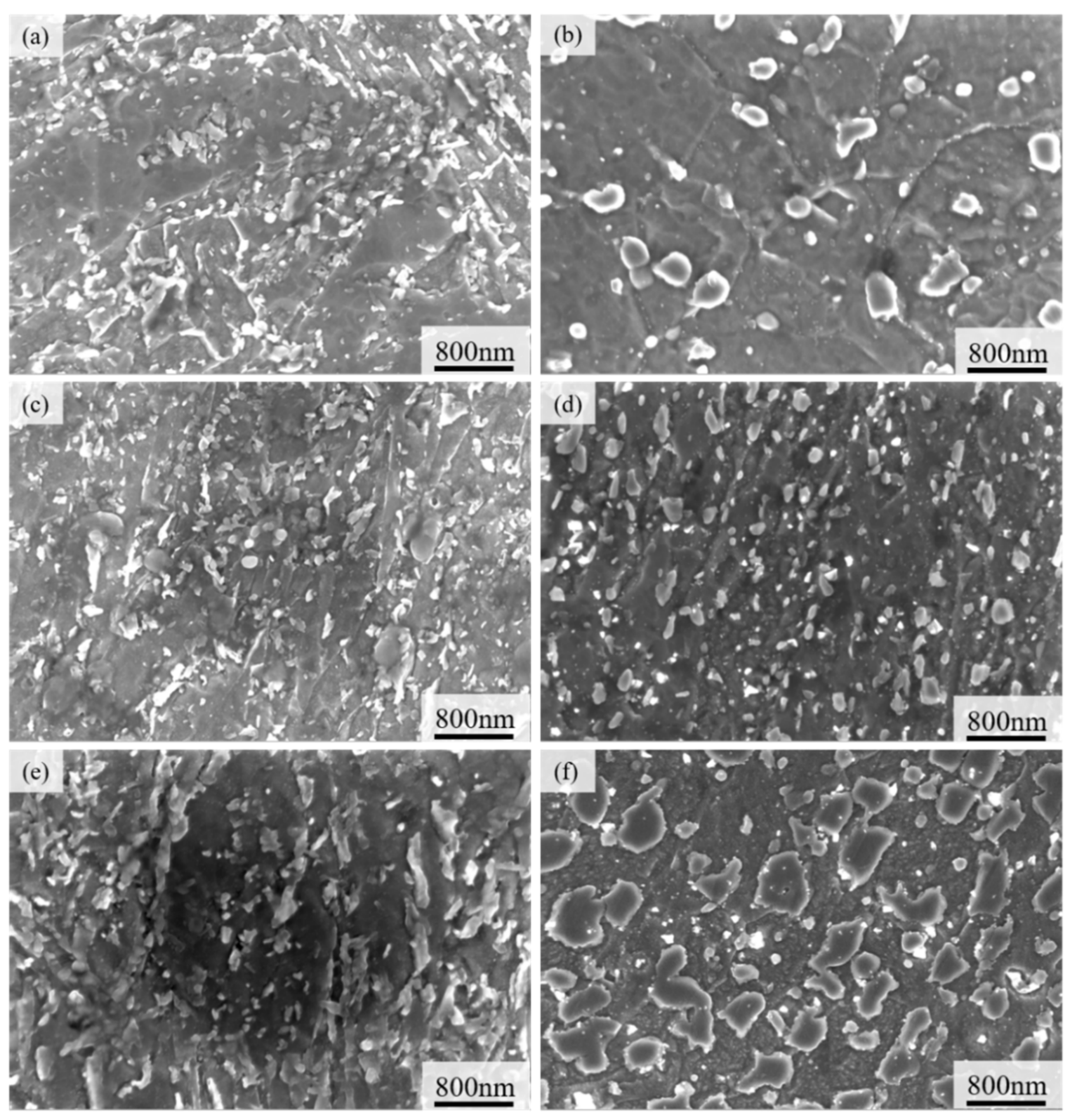

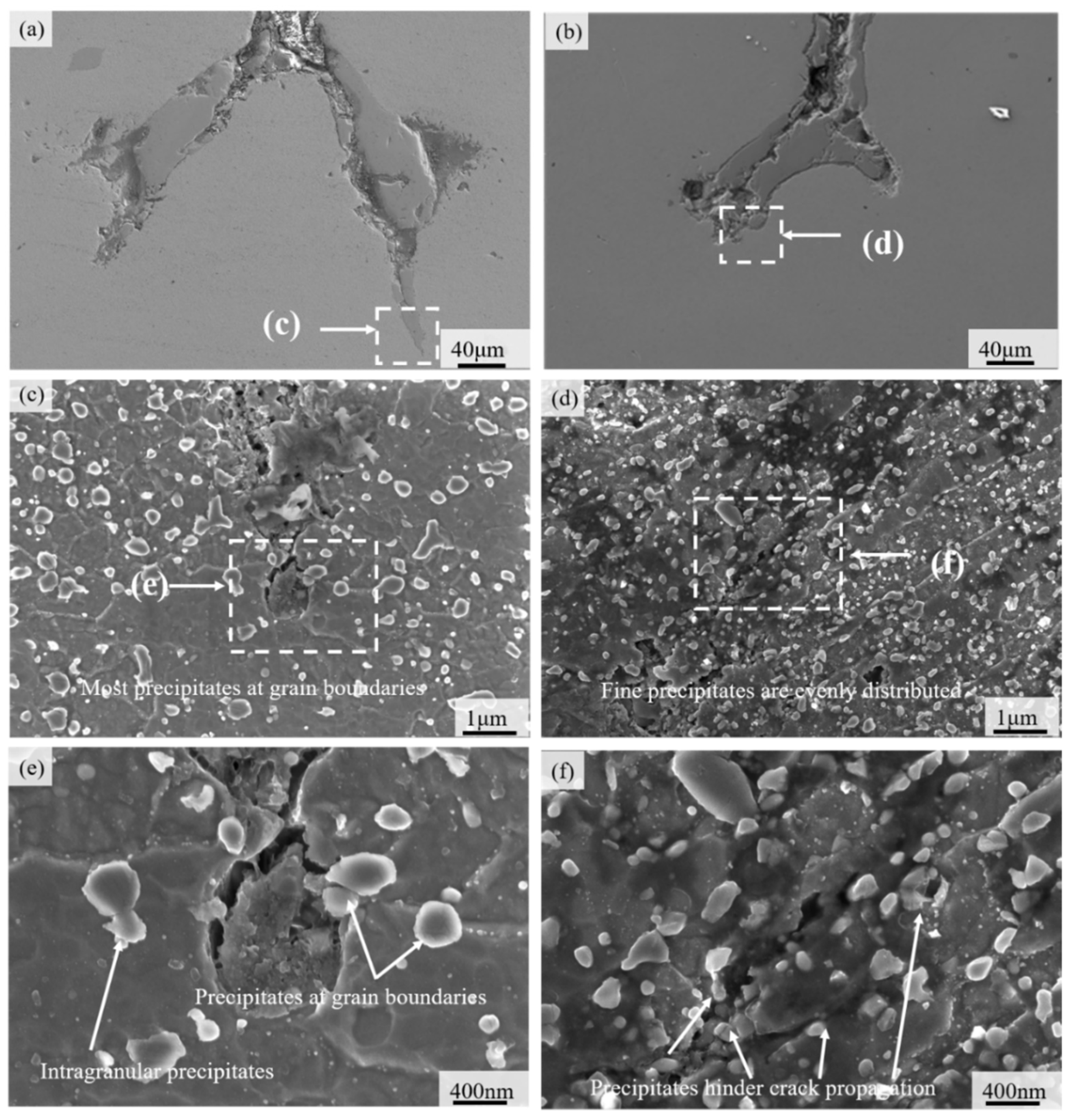
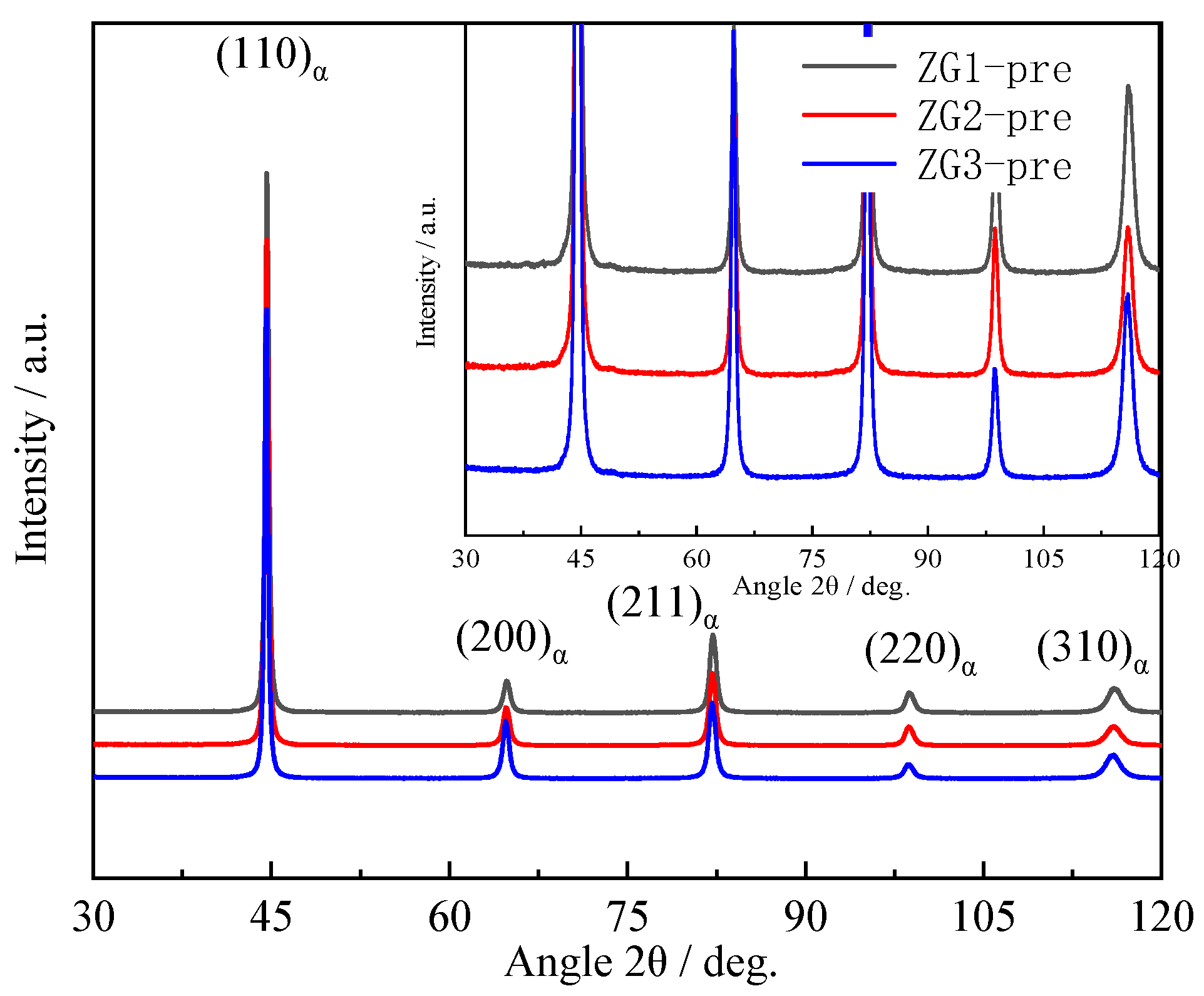
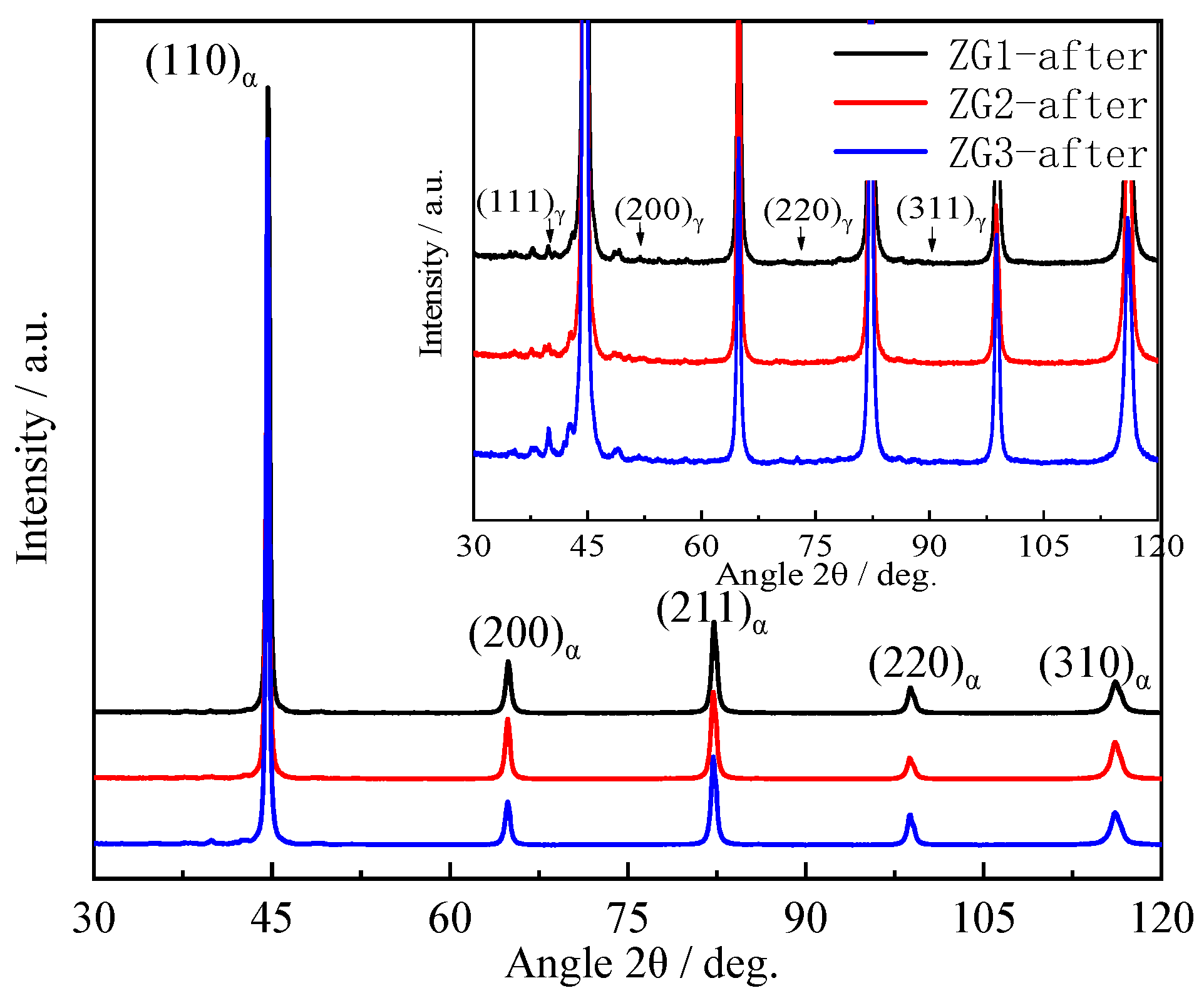
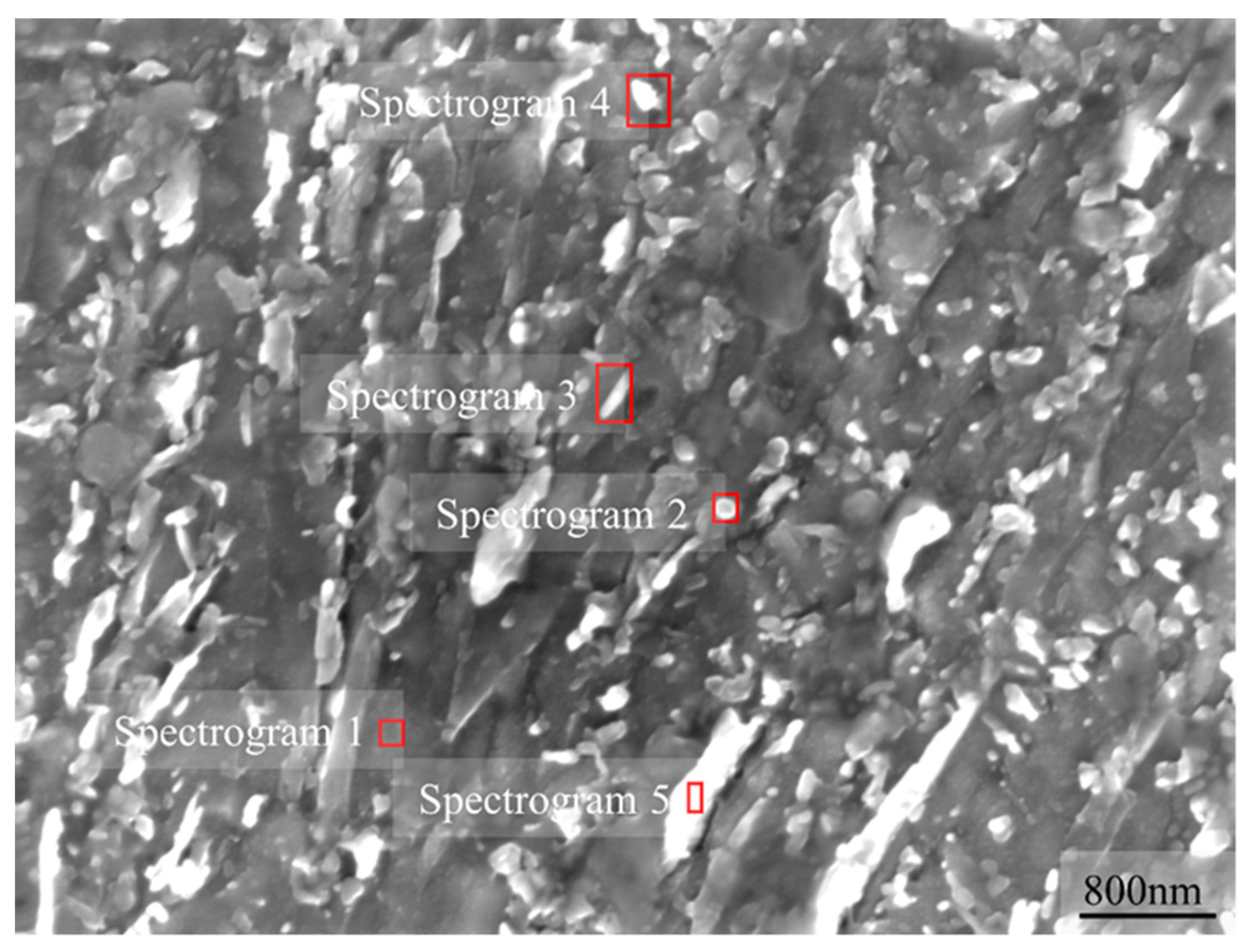

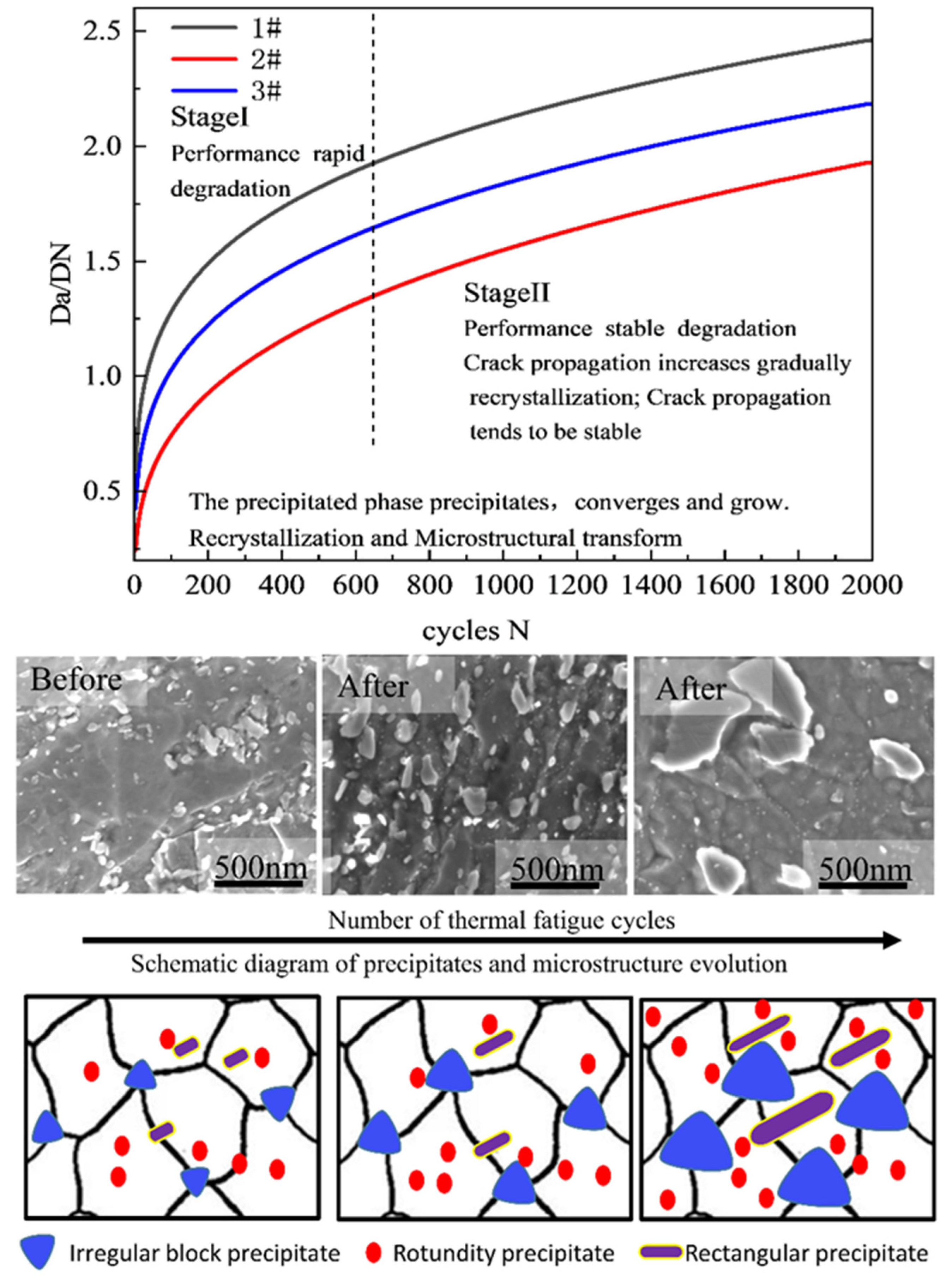
| NO | C | Si | Cr | Mo | Ni | Mn | V | Fe |
|---|---|---|---|---|---|---|---|---|
| ZG1 | 0.22 | 0.41 | 0.80 | 1.0 | 0.95 | 1.0 | - | Bal. |
| ZG2 | 0.30 | 0.50 | 1.60 | 0.80 | 0.95 | 1.0 | 0.1 | Bal. |
| ZG3 | 0.30 | 0.50 | 1.60 | 1.20 | 0.95 | 1.0 | - | Bal |
| NO\Element | Fe | C | Mn | Cr | Ni | Si | Mo | V | O |
|---|---|---|---|---|---|---|---|---|---|
| Point 1 | 71.77 | 18.37 | 0.65 | 6.84 | 0.3 | 0.67 | 0.44 | 0.11 | 0.84 |
| Point 2 | 70.13 | 13.80 | 0 | 8.97 | 0.45 | 0.63 | 0.27 | 0.1 | 5.66 |
| Point 3 | 70.64 | 19.00 | 1.85 | 6.64 | 0.60 | 0.71 | 0.39 | 0.17 | 0.9 |
| Point 4 | 71.48 | 17.89 | 2.64 | 4.72 | 0.57 | 0.66 | 0.34 | 0.12 | 1.59 |
| Point 5 | 72.04 | 15.56 | 3.79 | 5.23 | 0.6 | 0.63 | 0.37 | 0.21 | 1.46 |
| Linear Speed/(m/s) | 0.4 | 0.8 | 1.2 | 1.6 | 2.0 | Total |
|---|---|---|---|---|---|---|
| ZG1 | 19.4 | 28.6 | 52.7 | 46.9 | 15.7 | 163.3 |
| ZG2 | 26.5 | 16.1 | 34.5 | 53.3 | 19.3 | 149.7 |
| ZG3 | 27.6 | 32.6 | 57.8 | 62.3 | 27.2 | 207.5 |
Publisher’s Note: MDPI stays neutral with regard to jurisdictional claims in published maps and institutional affiliations. |
© 2022 by the authors. Licensee MDPI, Basel, Switzerland. This article is an open access article distributed under the terms and conditions of the Creative Commons Attribution (CC BY) license (https://creativecommons.org/licenses/by/4.0/).
Share and Cite
Wang, J.; Chen, Y.; Zuo, L.; Zhao, H.; Ma, N. Evaluation of Thermal Fatigue Life and Crack Morphology in Brake Discs of Low-Alloy Steel for High-Speed Trains. Materials 2022, 15, 6837. https://doi.org/10.3390/ma15196837
Wang J, Chen Y, Zuo L, Zhao H, Ma N. Evaluation of Thermal Fatigue Life and Crack Morphology in Brake Discs of Low-Alloy Steel for High-Speed Trains. Materials. 2022; 15(19):6837. https://doi.org/10.3390/ma15196837
Chicago/Turabian StyleWang, Jinnan, Yunbo Chen, Lingli Zuo, Haiyan Zhao, and Ninshu Ma. 2022. "Evaluation of Thermal Fatigue Life and Crack Morphology in Brake Discs of Low-Alloy Steel for High-Speed Trains" Materials 15, no. 19: 6837. https://doi.org/10.3390/ma15196837
APA StyleWang, J., Chen, Y., Zuo, L., Zhao, H., & Ma, N. (2022). Evaluation of Thermal Fatigue Life and Crack Morphology in Brake Discs of Low-Alloy Steel for High-Speed Trains. Materials, 15(19), 6837. https://doi.org/10.3390/ma15196837








